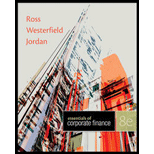
a)
To calculate:
The cash flow of Person M, a shareholder of the company, having 100 shares as per the current capital structure with an assumption that the company has a rate of dividend payment at 100%.
Introduction:
Leverage refers to the borrowing of an amount or debt to utilize for a purchase of equipment, inventory, and other assets of the company.
b)
To calculate: The cash flow of Person M as per the proposed capital structure, assuming that she has the same 100 shares.
Note: It is necessary to compute EPS (Earnings per share) under the planned capital structure to calculate the cash flow.
Introduction:
Leverage refers to the borrowing of an amount or debt to utilize for a purchase of equipment, inventory, and other assets of the company.
c)
To calculate: How Person M would convert her shares to re-establish the original capital structure.
To replicate the projected capital structure, the shareholder must sell their shares at 30% or 30 shares at an interest rate of 8%. Hence, compute the interest cash flow of the shareholder.
Introduction:
Leverage refers to the borrowing of an amount or debt to utilize for a purchase of equipment, inventory, and other assets of the company.
d)
To explain: The reason for the irrelevance in the capital structure of the company.
Introduction:
Leverage refers to the borrowing of an amount or debt to utilize for a purchase of equipment, inventory, and other assets of the company.
Want to see the full answer?
Check out a sample textbook solution
Chapter 13 Solutions
Essentials of Corporate Finance
 Essentials Of InvestmentsFinanceISBN:9781260013924Author:Bodie, Zvi, Kane, Alex, MARCUS, Alan J.Publisher:Mcgraw-hill Education,
Essentials Of InvestmentsFinanceISBN:9781260013924Author:Bodie, Zvi, Kane, Alex, MARCUS, Alan J.Publisher:Mcgraw-hill Education,

 Foundations Of FinanceFinanceISBN:9780134897264Author:KEOWN, Arthur J., Martin, John D., PETTY, J. WilliamPublisher:Pearson,
Foundations Of FinanceFinanceISBN:9780134897264Author:KEOWN, Arthur J., Martin, John D., PETTY, J. WilliamPublisher:Pearson, Fundamentals of Financial Management (MindTap Cou...FinanceISBN:9781337395250Author:Eugene F. Brigham, Joel F. HoustonPublisher:Cengage Learning
Fundamentals of Financial Management (MindTap Cou...FinanceISBN:9781337395250Author:Eugene F. Brigham, Joel F. HoustonPublisher:Cengage Learning Corporate Finance (The Mcgraw-hill/Irwin Series i...FinanceISBN:9780077861759Author:Stephen A. Ross Franco Modigliani Professor of Financial Economics Professor, Randolph W Westerfield Robert R. Dockson Deans Chair in Bus. Admin., Jeffrey Jaffe, Bradford D Jordan ProfessorPublisher:McGraw-Hill Education
Corporate Finance (The Mcgraw-hill/Irwin Series i...FinanceISBN:9780077861759Author:Stephen A. Ross Franco Modigliani Professor of Financial Economics Professor, Randolph W Westerfield Robert R. Dockson Deans Chair in Bus. Admin., Jeffrey Jaffe, Bradford D Jordan ProfessorPublisher:McGraw-Hill Education





